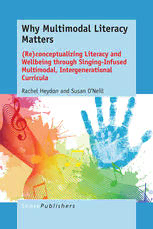
Why Multimodal Literacy Matters: (Re)conceptualizing Literacy and Wellbeing through Singing-Infused Multimodal, Intergenerational Curricula PDF
Preview Why Multimodal Literacy Matters: (Re)conceptualizing Literacy and Wellbeing through Singing-Infused Multimodal, Intergenerational Curricula
Why Multimodal Literacy Matters Why Multimodal Literacy Matters (Re)conceptualizing Literacy and Wellbeing through Singing-Infused Multimodal, Intergenerational Curricula Rachel Heydon Western University, Ontario, Canada and Susan O’Neill Simon Fraser University, British Columbia, Canada A C.I.P. record for this book is available from the Library of Congress. ISBN: 978-94-6300-706-1 (paperback) ISBN: 978-94-6300-707-8 (hardback) ISBN: 978-94-6300-708-5 (e-book) Published by: Sense Publishers, P.O. Box 21858, 3001 AW Rotterdam, The Netherlands https://www.sensepublishers.com/ All chapters in this book have undergone peer review. Printed on acid-free paper All Rights Reserved © 2016 Sense Publishers No part of this work may be reproduced, stored in a retrieval system, or transmitted in any form or by any means, electronic, mechanical, photocopying, microfilming, recording or otherwise, without written permission from the Publisher, with the exception of any material supplied specifically for the purpose of being entered and executed on a computer system, for exclusive use by the purchaser of the work. For my brother, James M. Heydon and our papa, Dr. Eugene T. Daly. Singing with the angels (R.H.) For my mother, Nancy Carney, who inspired many with her strength and wisdom (S.O.) TABLE OF CONTENTS Foreword ix Acknowledgements xi Chapter 1: Introduction 1 The Point of Departure for Why Multimodal Literacy Matters 2 Wellbeing, Literacy, and Singing: Literature Connections 5 Chapter 2: Intergenerational Multimodal Singing-Infused Curriculum 23 Intergenerational Contact and Intergenerational Programs 23 Foundations for the Curriculum 30 The Study 46 The Scene of the Program 49 Chapter 3: The Curriculum 53 The Lessons 54 Chapter 4: Towards a (Re)conceptualization of Wellbeing through Singing-Infused Multimodal, Intergenerational Curriculum 119 Affordances and Constraints of the Curriculum 120 Revisiting Wellbeing 134 References 139 Index 151 vii FOREWORD This book makes a very special contribution to an under-researched area of multi- modal literacy studies, dealing as it does with the intersection of intergenerational learning, well-being, and multimodal literacy education—specifically singing. The authors position the book firmly in generous and forward looking conceptions of literacy, and they anchor their research study tellingly in autobiographical material of their own experiences at different ages. These recollections, interspersed with the data reported in the book, give a sense of the long histories of learning that we all accumulate beyond the classroom. They begin to uncover the extent and variety of roles that music and singing play in the everyday life of people of all ages and cultures. This is an ambitious book in several respects, aiming to heal divides that have scarred literacy education in the past. First, it invites us to broaden our view of what counts as literacy to include meaning-making through song and the human voice—a fusion of music and poetry. It is becoming common to consider the visual modes of literacy education, but the soundscapes of literacy are still largely ignored despite their prominence in online and everyday communication. We are still mired in the outdated “great divide” of oral versus written modes of thought, the separation of the affective from the cognitive, and the individual from the collective. This book takes us a further step out of this mire. Second, the authors boldly cross the intergenerational divide, working with groups at the extremes of this—elders and children in their early-years—who have always been important to one another through the caregiving practices of grand parenting and of family and community exchange. The years of compulsory schooling are bypassed altogether in this research data, but it nevertheless holds implications for education at all ages. Third, it takes equally seriously the need to ground this work on an intergenerational singing curriculum in both theoretical rigour and practical precision. The data are carefully presented and discussed in relation to literacy and curriculum. Extended vignettes and lesson plans link practice with research and speak to a wide readership among researchers, teachers, and curriculum developers. The engaging format and the photographs serve to bring all the participants vividly to life. As the authors assert in the first chapter, the use of the human voice for meaning- making, for carrying emotions, historical narratives, poetry, and other forms of wisdom has to be among our earliest forms of communication as a species. The exuberance of song arguably more directly embodies these meanings than any other mode of communication. Rhyme, rhythm, tone, and pitch are underpinning features of spoken language itself. Perhaps for this reason singing has a special role in connecting with and expressing well-being. As the authors conclude: “Our ix
